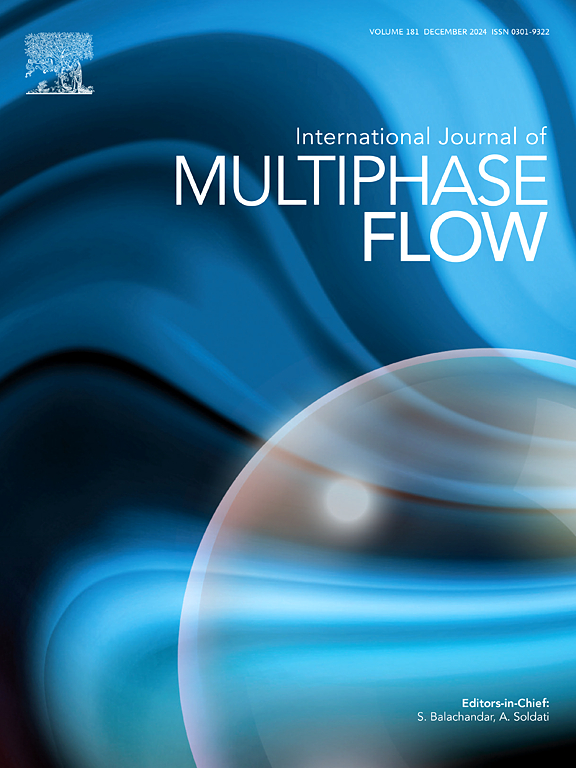An adaptive SPH-FVM method with optimized particle-mesh interpolation scheme for strongly compressible multiphase flows
IF 3.6
2区 工程技术
Q1 MECHANICS
International Journal of Multiphase Flow
Pub Date : 2025-04-22
DOI:10.1016/j.ijmultiphaseflow.2025.105256
引用次数: 0
Abstract
Strongly compressible multiphase flows, such as high-pressure bubble pulsations and jets, are typically characterized by complex interfaces with high density ratios, strong discontinuities, and long-term evolutions. As a result, traditional numerical methods often encounter significant challenges, including tracking multiphase interfaces, maintaining accuracy at discontinuous interfaces over long-term simulations, and enforcing physical non-reflection boundary. To address these issues, this paper introduces an adaptive SPH-FVM coupling model that integrates Riemann Smoothed Particle Hydrodynamics (Riemann-SPH) for computations within the core region, and Finite Volume Method (FVM) for calculations in other regions. It retains the benefits of the SPH method in handling large deformations and interface fragmentations, while leveraging the computational efficiency and boundary enforcement capabilities of the FVM method. This model is notably straightforward to implement and fully adaptive following initial setup. The predefined core particle region is adaptively adjusted, leading to a substantial reduction in the number of particles and an enhancement in overall computational efficiency. Furthermore, an optimized particle-mesh interpolation scheme (OPMIS) is proposed to handle the particle-mesh coupling at the interface, effectively mitigating numerical instability when high-pressure waves propagate from particles to meshes in shock problems. Additionally, the model is applied to simulate complex bubble behaviors in both free fields and near-wall boundaries. The numerical accuracy, efficiency, and robustness of the adaptive SPH-FVM model have been rigorously verified.

强可压缩多相流的自适应SPH-FVM方法及优化颗粒网格插值方案
强可压缩多相流,如高压气泡脉动和射流,其典型特征是具有高密度比、强不连续和长期演化的复杂界面。因此,传统的数值方法经常遇到重大挑战,包括跟踪多相界面,在长期模拟中保持不连续界面的精度,以及强制物理非反射边界。为了解决这些问题,本文引入了一种自适应SPH-FVM耦合模型,该模型将Riemann smooth Particle Hydrodynamics (Riemann- sph)用于核心区域的计算,将有限体积法(Finite Volume Method, FVM)用于其他区域的计算。它保留了SPH方法在处理大变形和界面破碎方面的优点,同时利用了FVM方法的计算效率和边界执行能力。这个模型非常容易实现,并且在初始设置之后完全自适应。自适应调整预定义的核心粒子区域,从而大大减少了粒子数量,提高了整体计算效率。在此基础上,提出了一种优化的粒子-网格插值方案(OPMIS)来处理粒子-网格在界面处的耦合,有效地缓解了冲击问题中高压波从粒子传播到网格时的数值不稳定性。此外,还应用该模型模拟了自由场和近壁边界的复杂气泡行为。仿真结果验证了自适应SPH-FVM模型的数值精度、效率和鲁棒性。
本文章由计算机程序翻译,如有差异,请以英文原文为准。
求助全文
约1分钟内获得全文
求助全文
来源期刊
CiteScore
7.30
自引率
10.50%
发文量
244
审稿时长
4 months
期刊介绍:
The International Journal of Multiphase Flow publishes analytical, numerical and experimental articles of lasting interest. The scope of the journal includes all aspects of mass, momentum and energy exchange phenomena among different phases such as occur in disperse flows, gas–liquid and liquid–liquid flows, flows in porous media, boiling, granular flows and others.
The journal publishes full papers, brief communications and conference announcements.

 求助内容:
求助内容: 应助结果提醒方式:
应助结果提醒方式:


